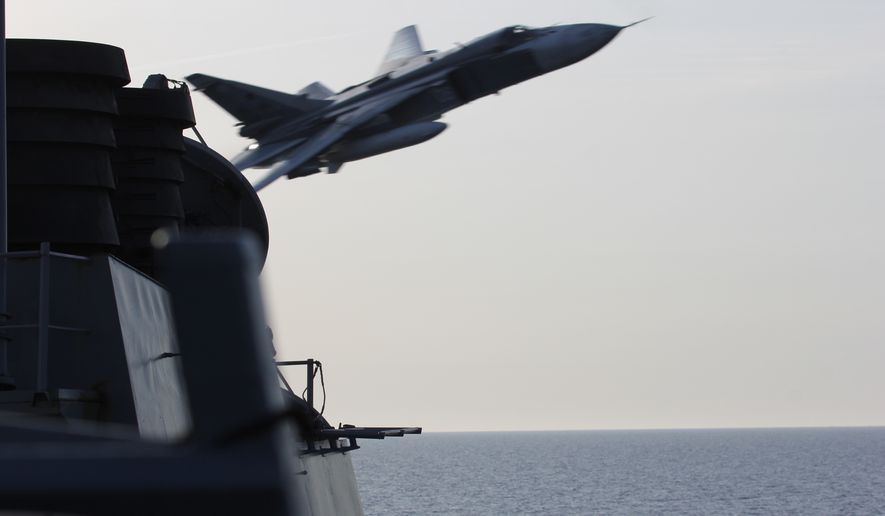The Navy’s top officer on Monday sought to play down recent Russian aggression against U.S. warships in Eastern Europe, but warned in the same breath that Moscow’s recent actions have brought tensions between the two nations a step closer to the boiling point.
Chief of Naval Operations Adm. John Richardson said Monday he is convinced that Russia “is not trying to provoke an incident” with its recent aggressive harassment of U.S. aircraft and warships operating in the Baltic Sea, including a much-discussed buzzing of a U.S. destroyer in the Baltic Sea by a pair of Russian fighter jets.
U.S. commanders in the region are “looking for a normalization” of operations from both American and Russian militaries over the next few months in the region, Adm. Richardson told reporters at the Pentagon.
“We will continue to see where this all levels out,” he said.
In another sign of the rising tensions along Russia’s border with the West, Defense Secretary Ashton Carter said Monday that NATO is weighing the establishment of a ground force that would rotate through the Baltic states and possibly Poland.
The proposed force would consist of four battalions, or 4,000 troops, and would supplement the 4,200-man Army armored brigade Pentagon officials plan to deploy separately to the region next February, Mr. Carter told reporters during a visit to U.S. European Command in Stuttgart, Germany.
Tensions between the two countries’ armed forces in the region ramped up earlier this month after Russian fighters and attack helicopters carried out simulated attacks on the USS Donald Cook, a Navy destroyer operating in the Baltic Sea.
For two days Russian pilots “made numerous, close-range and low-altitude passes” above the Donald Cook while it was conducting routine maritime drills, mimicking maneuvers used to strafe enemy targets.
On Saturday a Russian fighter jet reportedly conducted a “barrel roll” over a U.S. Air Force RC-135 reconnaissance plane flying over the Baltic Sea, flying within 100 feet of the American aircraft, according to press reports.
The Pentagon and NATO’s leadership chastised the Kremlin for its bellicose behavior, calling the maneuvers “unsafe and unprofessional,” a charge Moscow has rejected.
For his part, Adm. Richardson said the incidents in the Baltic Sea have the potential for a “tactical miscalculation” in which either U.S. or Russian forces would be forced to open fire on each other. Russia has repeatedly stated its behavior in the Baltic Sea has not violated international laws and standards governing military operations.
But Adm. Richardson insisted that the recent flyovers of U.S. warships and engagements of Russian warplanes with American military aircraft operating in international waters and airspace did violate the 1972 Incidents at Sea Agreement, a longstanding treaty banning such actions.
The rhetoric from Washington has also become more aggressive in recent days regarding Russia’s actions — Secretary of State John F. Kerry said the Donald Cook would have been justified in firing on the Russian aircraft.
Earlier this month, Army Gen. Curtis Scaparrotti told congressional lawmakers that all options — including military force — should be considered as possible responses should Russia continue to harass U.S. forces.
Gen. Scaparrotti, confirmed last week to lead the European command, said American forces will defend their right to operate in international waters, even in the face of ongoing Russian challenges.
• Carlo Muñoz can be reached at cmunoz@washingtontimes.com.




Please read our comment policy before commenting.